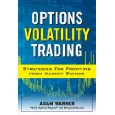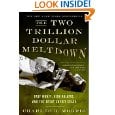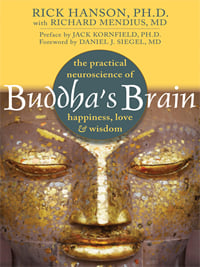
Options Volatility Trading
I’ve said before how much I enjoy following my virtual friend Jim Gobetz on Twitter (@aiki14). Jim is the Managing partner and CIO in a family office based in Philadelphia PA and Wilmington DE. He appears on StockTwitsTV for a pre-market show M-W-F mornings.
Jim tweeted about “Options Volatility Trading” By Adam Warner last week and I asked him to write a review for this month’s Book Lust column. He graciously agreed:
I guess I should begin by stating my bias up front, Adam was one of the first people I found on StockTwits, and I have found his “short form” writing to be of the highest quality. This “long form” effort enhanced that opinion greatly. I think there is literally something for everyone in the book, whether they are experienced guys from the trading floor or newbies getting their first taste of the world of options.
 The book begins with a bit of personal history which I found quite interesting. I love stories of the trading that went on, on the floor, back in the day and Adam brings the perspective of a young guy who thought he had a “legacy pass,” and from that starting point does a great job of laying out the workings of the options market and the thinking of the insiders.
The book begins with a bit of personal history which I found quite interesting. I love stories of the trading that went on, on the floor, back in the day and Adam brings the perspective of a young guy who thought he had a “legacy pass,” and from that starting point does a great job of laying out the workings of the options market and the thinking of the insiders.
He then moves on to the meat and potatoes first of the options themselves, and then the concepts of volatility, and it’s measure, and how traders use these metrics to gain an edge. His chapter on trading the VIX is particularly valuable in this day and age where the popular media feeds the public with constant heaps of this piece of data, without the least interest in whether that public has a clue to it’s limitations. Adam gives the reader a nice dose of reality in Ch. 11 where he addresses some of the popular conceptions and where they diverge from the truth.
The last quarter of the books gives the reader actionable strategies that put the prior chapters information into workable plays , charting concepts for derivatives, and finally a look at some of the rules that have changed and the consequences of these changes.
What I found most interesting was Adam displays an ability to take very technical subject matter and present it in a way that will satisfy the options technophile and not overwhelm the newly initiated.
I would recommend the book to anyone I thought was ready to made the move into options trading, and to all my friends and colleagues who trade them every day.
The Trillion Dollar Meltdown: Easy Money, High Rollers, and the Great Credit Crash
Another StockTwits friend is @Barrie Abalard, who conceals her identity with this pseudonym. Barrie’s a technical writer who worked in the financial and funds transfer software industry for fourteen years. She currently supports herself by trading stocks and writing. She is a fellow regular contributor to the Die Broke Blog.
As fellow writers, Barrie and I trade book recommendations, and one of hers to me was The Trillion Dollar Meltdown by Charles R. Morris. Her review follows:
 I first read this book in May, 2008 and, despite the occasional jargon and complex explanations of arcane financial instruments, found it compelling. I’ve since read it a second time. Morris has been scarily accurate concerning much of what transpired to create the economic crash of 2008. (Keep in mind that Morris wrote the book in 2007 for a February, 2008, publication date.)
I first read this book in May, 2008 and, despite the occasional jargon and complex explanations of arcane financial instruments, found it compelling. I’ve since read it a second time. Morris has been scarily accurate concerning much of what transpired to create the economic crash of 2008. (Keep in mind that Morris wrote the book in 2007 for a February, 2008, publication date.)
The author contends that the 2008 crash has its roots in what transpired after the last big economic crisis, which ended in 1982. He details how we progressed from leveraged buyouts of banks in the Eighties to the stock market crash of 1987 to the LTCM (Long-Term Capital Management) debacle of the Nineties, all in the first couple of chapters. Chapter 3, “A Tsunami of Dollars,” explains how the Fed’s “years of working the liquidity pump” flooded the world with dollars, artificially keeping markets afloat. Chapter 4 is about what he calls “The Great Unwinding,” accurately predicting what happened to the credit markets in 2008 and to our economy. Morris lays fault upon the ratings agencies as well, and anticipates the crash of the monoline insurers Ambac and MBIA. I’ll leave it to you to read the book and discover his predictions regarding what will happen (and is happening) to the USA post-crash.
I should note that Morris is cool to the concept of “free markets,” but that’s largely because he equates free markets with little to no regulation. (Even a free market, in my opinion, needs some regulation to restrain fraud and the darker side of self-interest.) Otherwise, I have little quibble with the underpinnings of the book.
Do not be fooled by the slimness of this volume—Morris covers everything in 160 succinct pages. Densely packed with explanatory material, it includes detailed descriptions of CDOs (collateralized debt obligations), CDSs (credit default swaps), and MBSs (mortgage-backed securities), as well as how mark-to-market works and its role in the credit crisis. If you want to understand the events leading up to the 2008 stock market crash and recession but don’t have a degree in economics or finance, I urge you to read The Trillion Dollar Meltdown.
Justice: What’s the Right Thing to Do?
I heard the author, Harvard government professor Michael J Sander interviewed on The Diane Rheme Show a couple of weeks ago and wish I had time to read this book.
This review from Publisher’s Weekly: Harvard government professor Sandel (Public Philosophy) dazzles in this sweeping survey of hot topics—the recent government bailouts, the draft, surrogate pregnancies, same-sex marriage, immigration reform and reparations for slavery—that situates various sides in the debates in the context of timeless philosophical questions and movements. Sandel takes utilitarianism, Kant’s categorical imperative and Rawls’s theory of justice out of the classroom, dusts them off and reveals how crucial these theories have been in the construction of Western societies—and how they inform almost every issue at the center of our modern-day polis. The content is dense but elegantly presented, and Sandel has a rare gift for making complex issues comprehensible, even entertaining (see his sections entitled “Shakespeare versus the Simpsons and “What Ethics Can Learn from Jack Benny and Miss Manners”), without compromising their gravity. With exegeses of Winnie the Pooh, transcripts of Bill Clinton’s impeachment hearing and the works of almost every major political philosopher, Sandel reveals how even our most knee-jerk responses bespeak our personal conceptions of the rights and obligations of the individual and society at large. Erudite, conversational and deeply humane, this is truly transformative reading.
Buddha’s Brain: The Practical Neuroscience of Happiness, Love and Wisdom
 Rick Hanson, PhD, wrote this with Richard Mendius. Hanson is a psychologist and teacher of contemplative neuroscience. He cofounded the Wellspring Institute for Neuroscience and Contemplative Wisdom,and has been a board member of Spirit Rock Meditation Center.
Rick Hanson, PhD, wrote this with Richard Mendius. Hanson is a psychologist and teacher of contemplative neuroscience. He cofounded the Wellspring Institute for Neuroscience and Contemplative Wisdom,and has been a board member of Spirit Rock Meditation Center.
Publisher’s Weekly review: The brain physiology associated with spiritual states has been fertile ground for researchers and writers alike. Neuropsychologist and meditation teacher Hanson suggests that an understanding of the brain in conjunction with 2,500-year-old Buddhist teachings can help readers achieve more happiness. He explains how the brain evolved to keep humans safe from external threats; the resulting “built-in negativity bias” creates suffering in modern individuals. Citing psychologist Donald Hebb’s conclusion that “when neurons fire together, they wire together,” Hanson argues that the brain’s functioning can be affected by simple practices and meditation to foster well-being. Classic Buddhist concepts such as the “three trainings”—mindfulness, virtuous action and wisdom—frame Hanson’s approach. Written with neurologist Mendius, the book includes descriptions and diagrams of brain functioning. Clear instructions guide the reader toward more positive thoughts and feelings. While the author doesn’t always succeed at clarifying complex physiology, this gently encouraging “practical guide to your brain” offers helpful information supported by research as well as steps to change instinctive patterns through the Buddhist path.
Conquering Fear: Living Boldly in an Uncertain World
 Library Journal: Rabbi Kushner, author of the international best seller When Bad Things Happen to Good People, now focuses on specific fears that impact our lives—terrorism, natural disasters, aging, job loss, death, change, and the destruction of humanity. Some may say that these events are brought on by sinful acts; however, Kushner, who does not believe in a vengeful God, points out that the words “do not be afraid” are mentioned in the Old and the New Testament more than 80 times. Kushner writes that fear can paralyze us, make us tense, and often keep us from taking action. He explains that a small dose of fear is healthy and that we can gain mastery by recognizing legitimate fears, dismissing exaggerated ones, and avoiding letting it keep us from activity. Prayer, meditation, and helping others are the keys to alleviating excessive fear. VERDICT: A short, easy-to-read book filled with a great deal of wisdom and words of hope along with some practical measures for reducing fear. Kushner’s message is inspirational and transcends all religious creeds and spiritualities.
Library Journal: Rabbi Kushner, author of the international best seller When Bad Things Happen to Good People, now focuses on specific fears that impact our lives—terrorism, natural disasters, aging, job loss, death, change, and the destruction of humanity. Some may say that these events are brought on by sinful acts; however, Kushner, who does not believe in a vengeful God, points out that the words “do not be afraid” are mentioned in the Old and the New Testament more than 80 times. Kushner writes that fear can paralyze us, make us tense, and often keep us from taking action. He explains that a small dose of fear is healthy and that we can gain mastery by recognizing legitimate fears, dismissing exaggerated ones, and avoiding letting it keep us from activity. Prayer, meditation, and helping others are the keys to alleviating excessive fear. VERDICT: A short, easy-to-read book filled with a great deal of wisdom and words of hope along with some practical measures for reducing fear. Kushner’s message is inspirational and transcends all religious creeds and spiritualities.
The Surprising Solution: Creating Possibility in a Swift and Severe World
Written by Bruce Piasecki, this review from Publisher’s Weekly: Piasecki (In Search of Environmental Excellence) updates his 2007 book (formerly titled World, Inc.) to address the current economic crisis and further explore the new frontier of sustainability, innovation and corporate social responsibility.
The underlying theme of this thought-provoking work is that big businesses have overtaken governments in terms of political and economic power—51 of the 100 largest economies in the world are now corporations; 300 multinational businesses control 25% of the world’s assets, and as much as 40% of world trade now occurs within these top multinationals. With their disproportionate power, big businesses now wield a tremendous ability to shape our social landscape, and the author impresses the importance of “Social Response Capitalism,” an approach that emphasizes a business’s “social brand” as well as the price and quality of their product or service. While the concepts are fascinating, the shifts in tone from academic to more casual create a jarring inconsistency. Still, for any reader who is a student of innovation and who seeks to understand the role of corporations in addressing global problems in the future, this is a treasure trove of provocative ideas.
